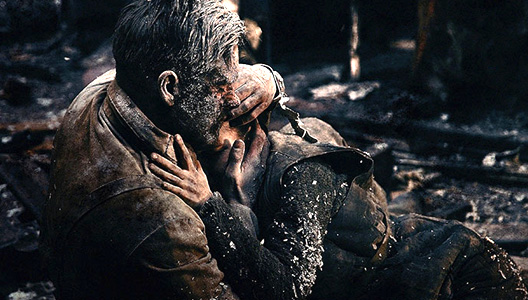
Based loosely on Soviet author Vasily Grossman’s novel, “Life and Fate,” the film Stalingrad (directed by Fedor Bondarchuk, screenplay by Sergey Snezhkin and Ilya Tilken), a treatment of World War II’s “bloodiest battle in human history,” is a laborious undertaking, subjecting viewers to an overwrought visual and auditory pummeling.
Considered by most historians to be the turning point of the war in Europe, the battle of Stalingrad (now Volgograd) took place from August, 1942 to February 1943. The German Sixth Army was pitted against the Red Army and in that attenuated battle an astounding 2 million people died or were wounded.
Stalingrad is a big-budget video war game extravaganza, the Russians vs. the Germans, with a barebones storyline. A compelling work of art allows one to suspend disbelief, and it is simply not possible to accept this film’s basic conceit from the very beginning. War is hell, to be sure: arbitrary, unfair, unnecessary, futile, stupid, but we only barely glimpse what this war was all about. An early miscue occurs when a building becomes a burning inferno, the Germans rush out, their bodies aflame, screaming toward the Soviet trenches, hoping to set their enemies on fire as well. The scene plays like a doomsday sci-fi movie involving zombies from the underworld.
The film’s paper-thin narrative thread involves five “fathers,” five Soviet soldiers teaming to rescue Katya, a teenage woman found inside the building they’re trying to defend. The voiceover narration sketches a bit of the back stories of these five, enough to humanize them for us, but barely enough to allow them to emerge as full characters through the smoke and ashes of war.
The building’s basement houses some of the original tenants, plus some other refugees, including the young Russian woman Masha, who becomes the lover of a German officer. Fittingly, the basement is tricked out with the bleak effects of a Piranesi dungeon. Strangely, no one looks particularly hungry, and the two young women who are the romantic objects of love appear especially well-groomed and fetching.
We do see a portrait of Lenin on an apartment wall in the building, Maxim Gorki on another, and facing the street we see an architectural bas-relief depicting Stalin and recognizable Soviet imagery. Yet the film focuses more on the Russianness of the soldiers (in what early on took on the name of Great Patriotic War), not the socialist, Soviet character of the USSR. It seems like a latter-day attempt to recall the hard-won glory of victory without acknowledging the social basis of the nation that won the battle, and the war. We even have an older soldier praying and speaking of God (no objection here except to ask if such activities would have been sanctioned by the Red Army’s political commissars). We do have one officer correcting a Russian soldier who speaks of “retards,” saying we have mental patients in Russia, but we don’t have “retards.”
Stalingrad appeals to a certain demographic: not the curious audience wishing to understand the importance of the battle, its complex geopolitical background, or the history of invasions of Russian soil. No, the ideal viewers here are young men whose film-going preferences run to 3D testosterone-driven mayhem, exploding bombs, bullets, and blood, very much like the trailers for many other shoot ’em up movies coming soon to theaters near you.
One of the five “fathers” is Sasha Nikiforov, a former opera singer, so we anticipate hearing him sing at some point, and of course we do. The aria he performs at Katya’s bombed-out birthday party is Puccini’s “E lucevan le stelle” from “Tosca,” the tenor solo Cavaradossi sings just before he is to die as a victim of assassination. The song returns on the soundtrack also for the German officer in command, telling us that all death in war is horrible. A question occurs: Is not the death of a defender of his homeland more poignant than that of the invader?
An epilogue from the narrator says that Stalingrad turned the course of the war, and that millions and millions of people were liberated from the Nazi threat. Fortunately, he says, he never had to know another war. The filmmakers have conveniently forgotten the decade-long Afghanistan episode.
If the viewer is familiar with the basic story of Stalingrad, Stalingrad won’t serve to advance your knowledge or educe your feelings of empathy. Unless 3D testosterone is your thing, stay away from this one.
Director: Fedor Bondarchuk
Writers: Sergey Snezhkin, Ilya Tilkin
Stars: Mariya Smolnikova, Yanina Studilina, Pyotr Fyodorov
IMAX 3D, rated R for scenes of war violence, 131 minutes
Photo: Still from Stalingrad.













Comments